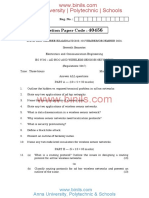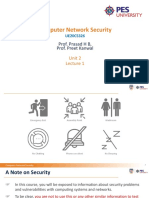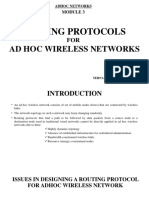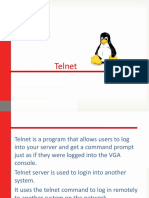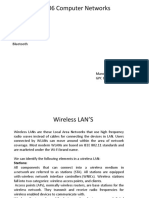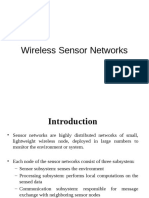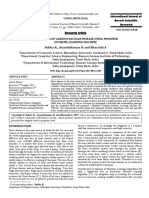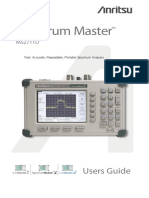0% found this document useful (0 votes)
46 views42 pagesChapter 2 - Ad-Hoc and Sensor Networks
This document provides an overview of ad-hoc and sensor networks. It discusses the types of networks including cellular networks, wireless ad-hoc networks, and sensor networks. It then focuses on mobile ad-hoc networks (MANETs), describing their characteristics such as dynamically changing topology, limited power, and decentralized control. The document outlines some applications of ad-hoc networks and discusses challenges like routing. It also categorizes routing protocols for MANETs as proactive, reactive, or hybrid and lists some examples. Finally, it briefly mentions that sensor networks promise to revolutionize sensing in various application domains.
Uploaded by
yetsedawCopyright
© © All Rights Reserved
We take content rights seriously. If you suspect this is your content, claim it here.
Available Formats
Download as PDF, TXT or read online on Scribd
0% found this document useful (0 votes)
46 views42 pagesChapter 2 - Ad-Hoc and Sensor Networks
This document provides an overview of ad-hoc and sensor networks. It discusses the types of networks including cellular networks, wireless ad-hoc networks, and sensor networks. It then focuses on mobile ad-hoc networks (MANETs), describing their characteristics such as dynamically changing topology, limited power, and decentralized control. The document outlines some applications of ad-hoc networks and discusses challenges like routing. It also categorizes routing protocols for MANETs as proactive, reactive, or hybrid and lists some examples. Finally, it briefly mentions that sensor networks promise to revolutionize sensing in various application domains.
Uploaded by
yetsedawCopyright
© © All Rights Reserved
We take content rights seriously. If you suspect this is your content, claim it here.
Available Formats
Download as PDF, TXT or read online on Scribd
/ 42





